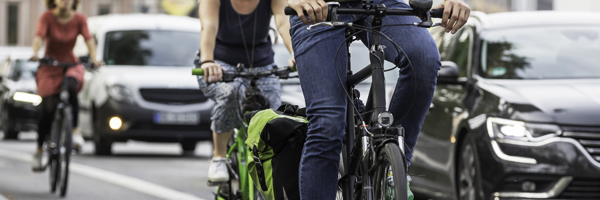
Passing a bicyclist on the road can be nerve-wracking and potentially dangerous for the cyclist and the driver. Ample bicycle-passing distance, driving speed and knowing which person has the right of way are all important factors to pass a cyclist safely and successfully.
Where can bikes go?
You might wonder if bicycles are permitted on sidewalks, roads or highways in your area. According to Edmunds.com, cyclists who are 10 years old and older “should behave as though they were vehicles on the street.” The National Highway Traffic Safety Administration (NHTSA) adds cyclists should ride in the same direction as traffic and “obey street signs, signals and road markings, just like a car.” Check your local regulations to see if sidewalk riding is legal where you live.
3 things to do before you pass a bicycle on the road
To pass a cyclist safely, do these three things when you drive by:
- Go the speed limit or slow down to pass a bicycle. The NHTSA advises to drive defensively, but do not underestimate the speed of the cyclist. Driving at a reduced speed also helps bicyclists feel safer on the road.
- Provide enough bicycle passing distance to make sure you and the cyclist are safe. The NHTSA says to “pass bicyclists as you would any other vehicle — when it’s safe to move over into an adjacent lane.” The rule of thumb is to pass a cyclist with at least three feet of clearance. In fact, more than 20 states require drivers to provide approximately three feet of passing distance for cyclists. According to the National Conference of State Legislators (NCSL), some states require motorists to change lanes when passing a cyclist if more than one lane is proceeding in the same direction. Check your state law to find out how much room you should give to pass a bicycle in your area.
- Have a “share the road” mentality. Drivers and cyclists have the same rights on the road and are expected to follow the same rules. It’s important for you, the driver, to do your part to keep the roadways safe for everyone.
Be patient, empathetic and cautious toward cyclists on the road to help everyone stay safe. When you remember that you have a vehicle to protect you in a collision and cyclists do not, it’s easier to keep cyclists’ vulnerability in mind.
Turning and cyclist safety
To minimize the chance of car-cycle collisions, be aware of where cyclists are before you make a turn.
For right turns, pay attention if you recently passed a bicycle safely. The same rider could be approaching quickly and collide with your vehicle as you turn right. The NHTSA advises to stop completely and look left-right-left then behind to turn right on red. Check your mirrors to make a continuous turn with caution.
For left turns, anticipate oncoming cyclists just like vehicles. It can be difficult to gauge how fast a cyclist is pedaling, so proceed with caution. Edmunds.com says, “After a collision, a driver often says he didn’t realize the cyclist was going that fast.” If you are unsure if you have enough space and time to complete a safe left turn, wait until the cyclist passes.
No matter which direction you turn, use your turn signal to indicate where you are going and help put distance between the cyclist and car. Just like turn signals advise other drivers where you are going, they are crucial to help cyclists anticipate lane changes and turns from surrounding vehicles.

Learn about our
Auto Insurance
4 pointers about sharing the road
While you’re driving and sharing the road with cyclists, remember these four things:
- Drivers and cyclists have the same responsibility on the road. Each party must abide by the same laws including traffic, roadway and street sign rules.
- Keep an eye out for cyclists when the weather is pleasant. Most riders aren’t out during rainy days, so be mindful that clear skies and dry pavements are the best conditions for cyclists and they are more likely to be on the road with you.
- It’s common courtesy to provide at least three feet of distance between your vehicle and the cyclist when you pass, and it’s required by law in most states. For added safety, slow down and switch lanes to provide more room for riders.
- Try and think of cyclists on the road as people you know and love. You might be surprised how much that practice can change your perspective about sharing the road.
Final thoughts
You can make roads and highways safer for cyclists and drivers alike. Use these pointers and help spread the “share the road” mindset to your friends and family to keep everyone safe while driving and riding.
This article is for informational and suggestion purposes only. Implementing these suggestions does not guarantee coverage. If any policy coverage descriptions in this article conflict with the language in the policy, the language in the policy applies. For full details on Grange’s auto insurance, coverages and discounts, contact your local independent agent.
References:
Bicycle Safety – NHTSA.gov
Edmunds
Bicycling.com
Bicycling.com – How Drivers Should Safely Pass a Cyclist
National Conference of State Legislatures – Safely Passing Bicyclists Chart
American Safety Council